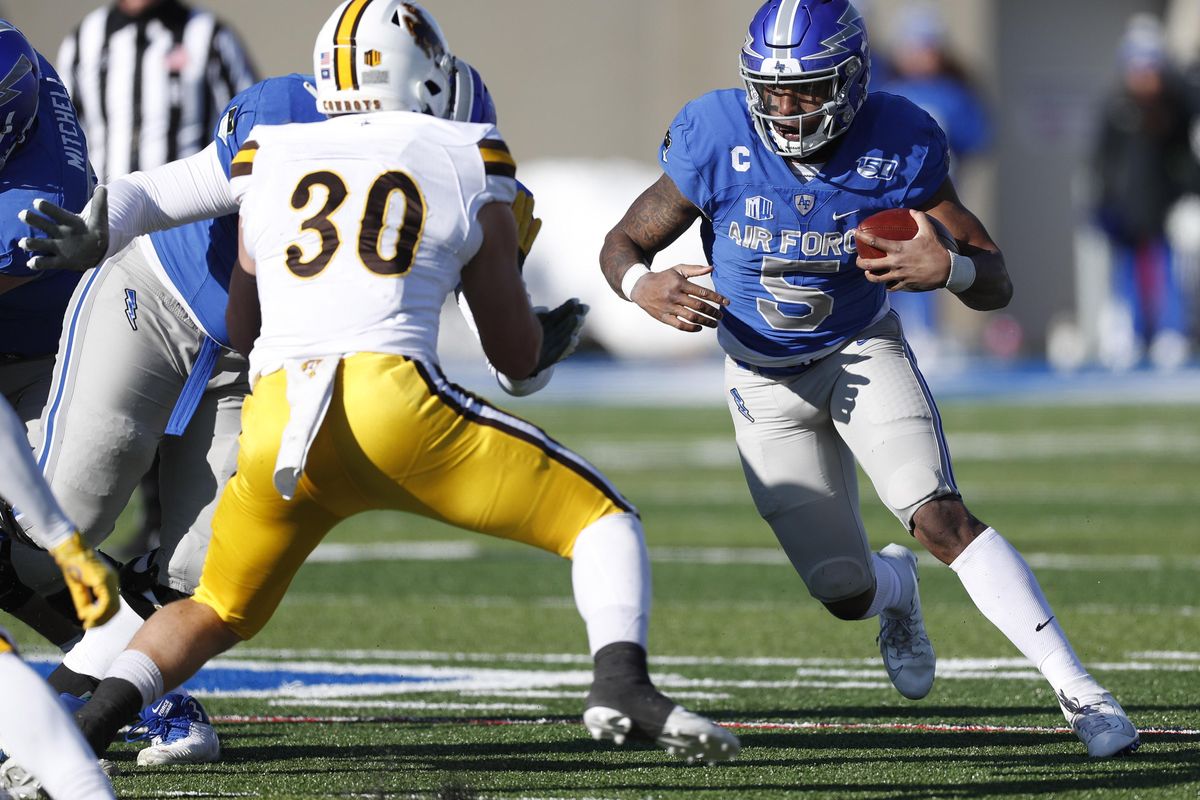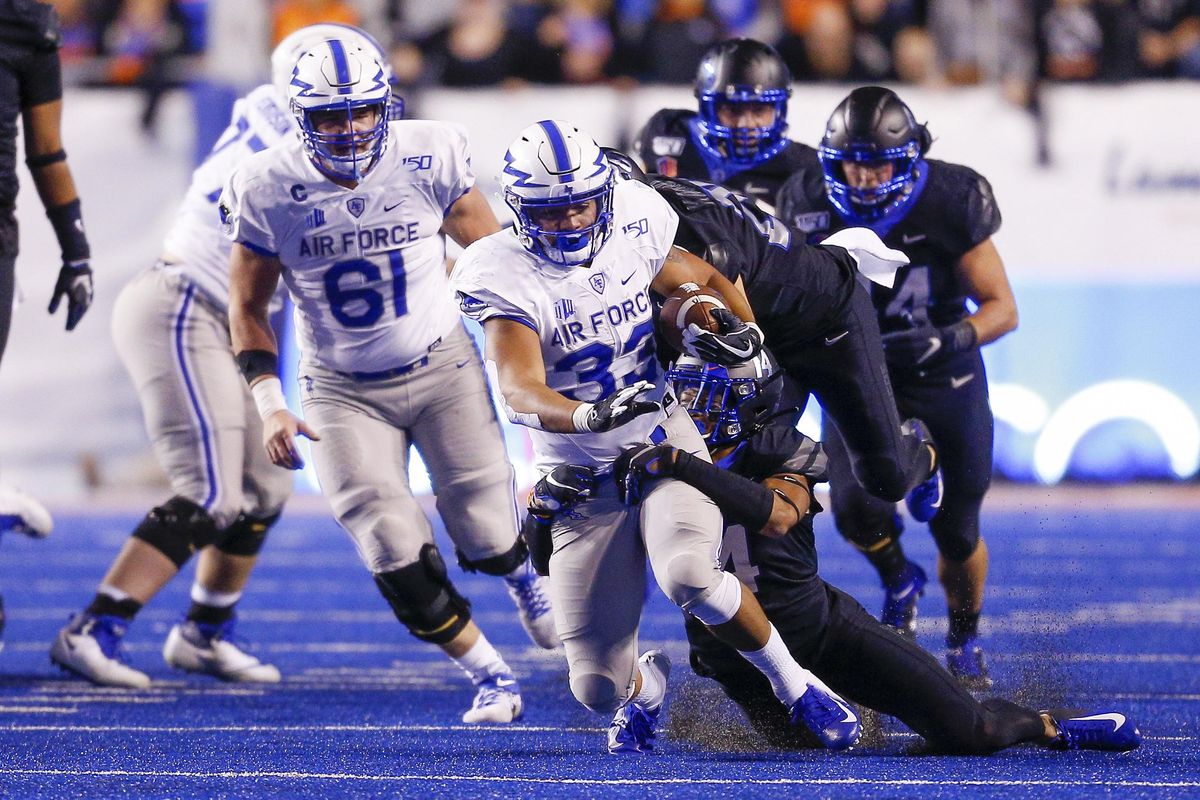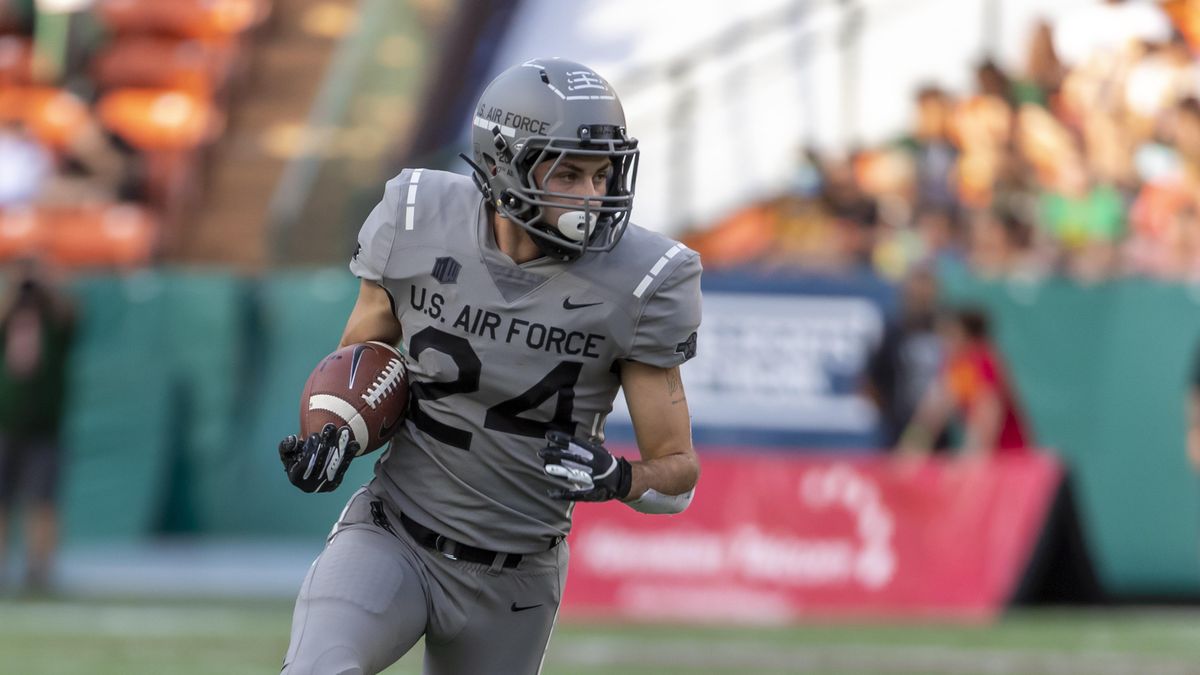Ready or not, Air Force and its vaunted triple option are coming for Washington State in Cheez-It Bowl
Air Force fullback Taven Birdow (33) fights for more yards as Boise State safety Khafari Buffalo (14) tackles him from behind in the first half of an NCAA college football game, Friday, Sept. 20, 2019, in Boise, Idaho. (Steve Conner / AP)
PULLMAN – Most of his teammates have seen nothing like it, but Justus Rogers already has a pretty good beat on the unconventional offense Washington State is up against this week when it faces Air Force in the Cheez-It Bowl.
The middle linebacker doesn’t claim to have an expert-level understanding of the triple option, but the run-heavy offense also isn’t a foreign language to him.
Much of the ideology behind the triple option is similar to the offense Rogers ran in high school at 3A juggernaut Bellevue, where the “wing-T” has been an institution for more than a decade.
It would’ve been helpful for Rogers to see the offense in practice every day as a linebacker. Even better, he got to know it as Bellevue’s quarterback, leading the Wolverines to a 24-3 record in his two seasons as a starter and multiple appearances in the Washington State 3A title game.
“It has some similarities and some differences as well, but they just rely on playing downhill,” Rogers said. “Air Force is one of the top rushing offenses in the country, so we just have to make sure we read our keys and stay disciplined.”
But it’s been four years since Rogers last wore a Bellevue uniform and he’s only one of 11 defensive starters who’ll be required to do their part when the Cougars take on the Falcons on Friday at Chase Field in Phoenix.
For all the challenges that come with defending the triple option – Air Force’s variation of it is also known as the “flexbone” – the most important one is the probably the least complicated.
Well, in theory.
“Everybody’s got to do their job, because you have to have all the space on the field covered as well as the personnel,” Cougars coach Mike Leach said. “It’s the ultimate in executing your job.”
The Falcons average 57.1 rushing attempts per game and 292.5 yards per game, which puts them third nationally behind only two other service academies who employ an identical offensive strategy: Navy at 363.7 ypg and Army at 297.2 ypg.
The diversity of the triple option is not necessarily in a traditional balance between run plays and pass plays, but in the variety of ways the Falcons can move the ball 10 yards on the ground.
“Just having good eyes, discipline, all those good things,” said cornerback George Hicks III, asked what the Cougars can do to counter the triple option. “Fundamentals. It’s going to be a big fundamentals game.”
Quarterback Donald Hammond III has rushed for 491 yards and 11 touchdowns this season, and if the Cougars choose to focus on his other weapons in the backfield, the next thing they see could be his blue No. 5 trotting into the end zone.
In many ways, defending the triple option is a numbers game. Since Air Force employs its quarterback as a runner, and because the system relies on reading defensive movement rather than blocking it, the Falcons have an extra-man advantage that allows them to carve out bigger holes or put two players on the opponent’s stud defensive lineman or linebacker.
And, if WSU does hunker down and throw multiple bodies at Hammond, he’s liable to flip the ball to running back Kadin Remsburg, a small, swift junior who’s spent this season busting through big holes and slipping through small creases to the tune of 872 yards and seven touchdowns.
Even if the Cougars do have a handle on both the QB run and pitch, it still doesn’t mean they’ve stymied the triple option. The fullback dive is the third fundamental play out of Troy Calhoun’s offense. It’s often used to keep defenses honest, but equally potent if it’s not accounted for.
Air Force’s fullbacks, Timothy Jackson and Taven Birdow, add another 1,576 rushing yards and 12 touchdowns to the Falcons’ absurd rushing totals.
WSU’s defensive linemen figure to be much more involved on Friday than the linebackers, and the linebackers much more than the defensive backs, so in the trenches, nose tackle Dallas Hobbs said the key to playing well is “just making sure we’re staying extra low and just doing our job.”
Hobbs added: “Because there’s going to be a lot of moving parts I feel like and we’ve just got to hunker down that middle and spill it more.”
Another peculiarity when it comes to the Falcons are the offensive linemen, who aren’t intimidating on paper and average just 6-foot-3 and 280 pounds. But they’re quicker than most the Cougars see and utilize cut-blocking to open running paths for the tailbacks, fullbacks and quarterback.
“You just have to stay more aware of your surroundings I feel like, and you just have to keep moving your feet because you don’t want to be planted in there and have someone come from this side and this side,” Hobbs said. “So just being more aware and keeping your feet moving.”
The Cougars have had various running backs and receivers shuffling in and out of practice as their scout team quarterback, though it’s usually been true freshman slot receiver Billy Pospisil imitating Hammond.
A few of WSU’s offensive players, who won’t have to deal with the triple option headache, have offered their thoughts on Air Force’s unique system since the bowl pairing was announced.
“I watched bits of that Navy-Army game,” quarterback Anthony Gordon said. “It’s pretty crazy, it moves quick. You’ve got to keep your eyes on the right spot and all that. I’m confident our defense is going to come out and play hard and play well against them.”
Gordon and the Air Raid have to do their part, as well. The Falcons have lost the time of possession battle just twice this season. They keep the ball 33 minutes on average, which underlines the importance of being efficient on offense and avoiding turnovers.
“We’ve just got to be crucial about every time the offense gets the ball we need to score,” said WSU running back Max Borghi, who was familiar with Air Force while growing up in the state of Colorado and turned down an offer to play for the Falcons as a tailback. “Obviously when they run it, they eat up the whole clock. So every drive’s going to be important so we’ve just got to do our best out there and make plays.”
Leach has long been fascinated with the triple option, and the WSU coach stated a few weeks ago he’d experiment with Calhoun’s offense if he wasn’t so entrenched in his own Air Raid system. While Leach said teaching the triple option would be “quite an overhaul,” noting “you can’t just switch it back and forth,” he also said “throughout my career I’ve tried to learn as much from it as I can.”
When Leach taught an “Insurgent Warfare & Football Strategy” course in Pullman last spring, one of the preliminary application questions was, “Is the wishbone (a system that derives from the triple option family) a viable offense for the NFL? Why/why not?”
Leach agreed with approximately 50 percent of students who theorized it could work at the next level.
“I think it would be very difficult for teams to prepare for a triple-option team,” he said. “I do think you’d go through some quarterbacks and you’d have to make sure all your quarterbacks can run. … I don’t think you’d want to have quarterbacks where it’s mixed, where you’ve got the drop-back guy and the option guy. I think you want all three of them to be option guys.
“And yeah I do think it would work.”
Just as long as it doesn’t five days from now.



